FNSFMB503 Present Broking Options: Complex Client Risk Assessment
VerifiedAdded on 2023/06/05
|28
|8378
|188
Practical Assignment
AI Summary
This assignment solution for FNSFMB503 focuses on presenting broking options to clients with complex needs, specifically addressing risk issues. The document includes an assessment guide outlining the competency-based assessment process, including how students will be assessed, what happens if they are deemed 'Not Yet Competent,' and the appeals process. It also details assessor responsibilities, formatting guidelines for assessments, and how to reference sources. The core of the assignment involves explaining risk issues in a pamphlet format for clients, covering borrowing risk and gearing, specific product risk, institutional risk, risk factors and return expectations, and volatility of income and capital. It also includes an assessment cover sheet and a written activity checklist.
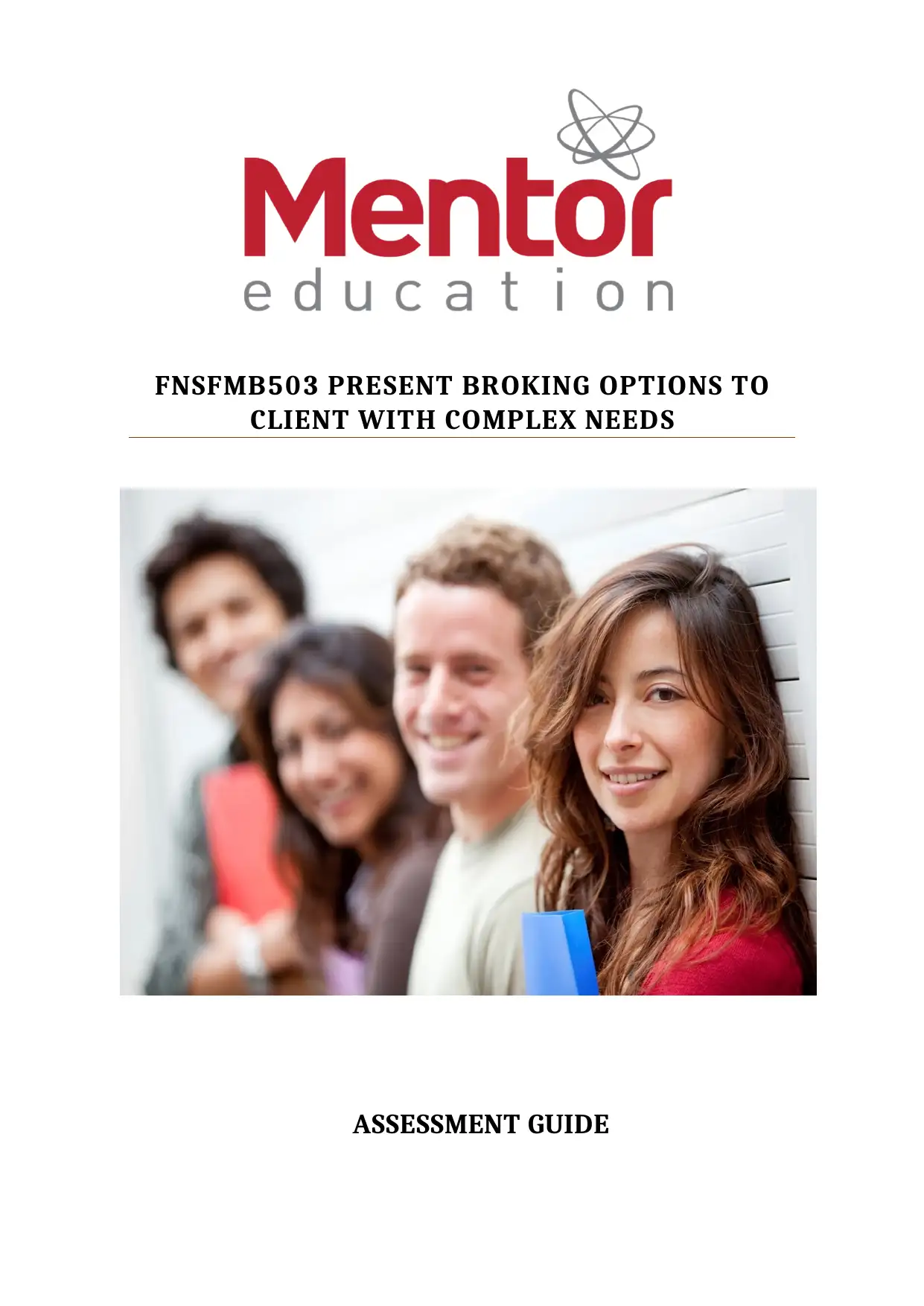
FNSFMB503 PRESENT BROKING OPTIONS TO
CLIENT WITH COMPLEX NEEDS
ASSESSMENT GUIDE
CLIENT WITH COMPLEX NEEDS
ASSESSMENT GUIDE
Paraphrase This Document
Need a fresh take? Get an instant paraphrase of this document with our AI Paraphraser
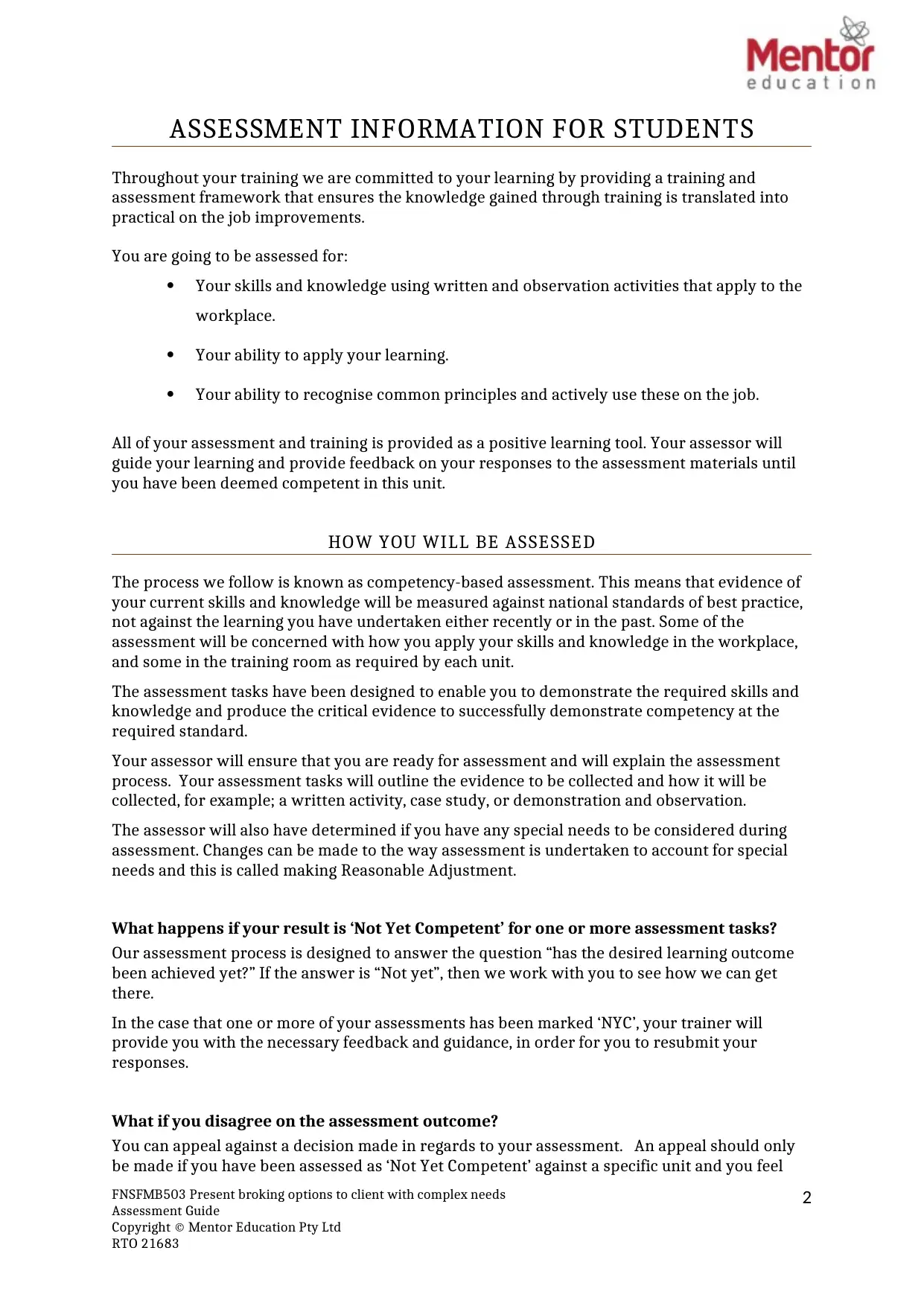
ASSESSMENT INFORMATION FOR STUDENTS
Throughout your training we are committed to your learning by providing a training and
assessment framework that ensures the knowledge gained through training is translated into
practical on the job improvements.
You are going to be assessed for:
Your skills and knowledge using written and observation activities that apply to the
workplace.
Your ability to apply your learning.
Your ability to recognise common principles and actively use these on the job.
All of your assessment and training is provided as a positive learning tool. Your assessor will
guide your learning and provide feedback on your responses to the assessment materials until
you have been deemed competent in this unit.
HOW YOU WILL BE ASSESSED
The process we follow is known as competency-based assessment. This means that evidence of
your current skills and knowledge will be measured against national standards of best practice,
not against the learning you have undertaken either recently or in the past. Some of the
assessment will be concerned with how you apply your skills and knowledge in the workplace,
and some in the training room as required by each unit.
The assessment tasks have been designed to enable you to demonstrate the required skills and
knowledge and produce the critical evidence to successfully demonstrate competency at the
required standard.
Your assessor will ensure that you are ready for assessment and will explain the assessment
process. Your assessment tasks will outline the evidence to be collected and how it will be
collected, for example; a written activity, case study, or demonstration and observation.
The assessor will also have determined if you have any special needs to be considered during
assessment. Changes can be made to the way assessment is undertaken to account for special
needs and this is called making Reasonable Adjustment.
What happens if your result is ‘Not Yet Competent’ for one or more assessment tasks?
Our assessment process is designed to answer the question “has the desired learning outcome
been achieved yet?” If the answer is “Not yet”, then we work with you to see how we can get
there.
In the case that one or more of your assessments has been marked ‘NYC’, your trainer will
provide you with the necessary feedback and guidance, in order for you to resubmit your
responses.
What if you disagree on the assessment outcome?
You can appeal against a decision made in regards to your assessment. An appeal should only
be made if you have been assessed as ‘Not Yet Competent’ against a specific unit and you feel
FNSFMB503 Present broking options to client with complex needs
Assessment Guide
Copyright © Mentor Education Pty Ltd
RTO 21683
2
Throughout your training we are committed to your learning by providing a training and
assessment framework that ensures the knowledge gained through training is translated into
practical on the job improvements.
You are going to be assessed for:
Your skills and knowledge using written and observation activities that apply to the
workplace.
Your ability to apply your learning.
Your ability to recognise common principles and actively use these on the job.
All of your assessment and training is provided as a positive learning tool. Your assessor will
guide your learning and provide feedback on your responses to the assessment materials until
you have been deemed competent in this unit.
HOW YOU WILL BE ASSESSED
The process we follow is known as competency-based assessment. This means that evidence of
your current skills and knowledge will be measured against national standards of best practice,
not against the learning you have undertaken either recently or in the past. Some of the
assessment will be concerned with how you apply your skills and knowledge in the workplace,
and some in the training room as required by each unit.
The assessment tasks have been designed to enable you to demonstrate the required skills and
knowledge and produce the critical evidence to successfully demonstrate competency at the
required standard.
Your assessor will ensure that you are ready for assessment and will explain the assessment
process. Your assessment tasks will outline the evidence to be collected and how it will be
collected, for example; a written activity, case study, or demonstration and observation.
The assessor will also have determined if you have any special needs to be considered during
assessment. Changes can be made to the way assessment is undertaken to account for special
needs and this is called making Reasonable Adjustment.
What happens if your result is ‘Not Yet Competent’ for one or more assessment tasks?
Our assessment process is designed to answer the question “has the desired learning outcome
been achieved yet?” If the answer is “Not yet”, then we work with you to see how we can get
there.
In the case that one or more of your assessments has been marked ‘NYC’, your trainer will
provide you with the necessary feedback and guidance, in order for you to resubmit your
responses.
What if you disagree on the assessment outcome?
You can appeal against a decision made in regards to your assessment. An appeal should only
be made if you have been assessed as ‘Not Yet Competent’ against a specific unit and you feel
FNSFMB503 Present broking options to client with complex needs
Assessment Guide
Copyright © Mentor Education Pty Ltd
RTO 21683
2
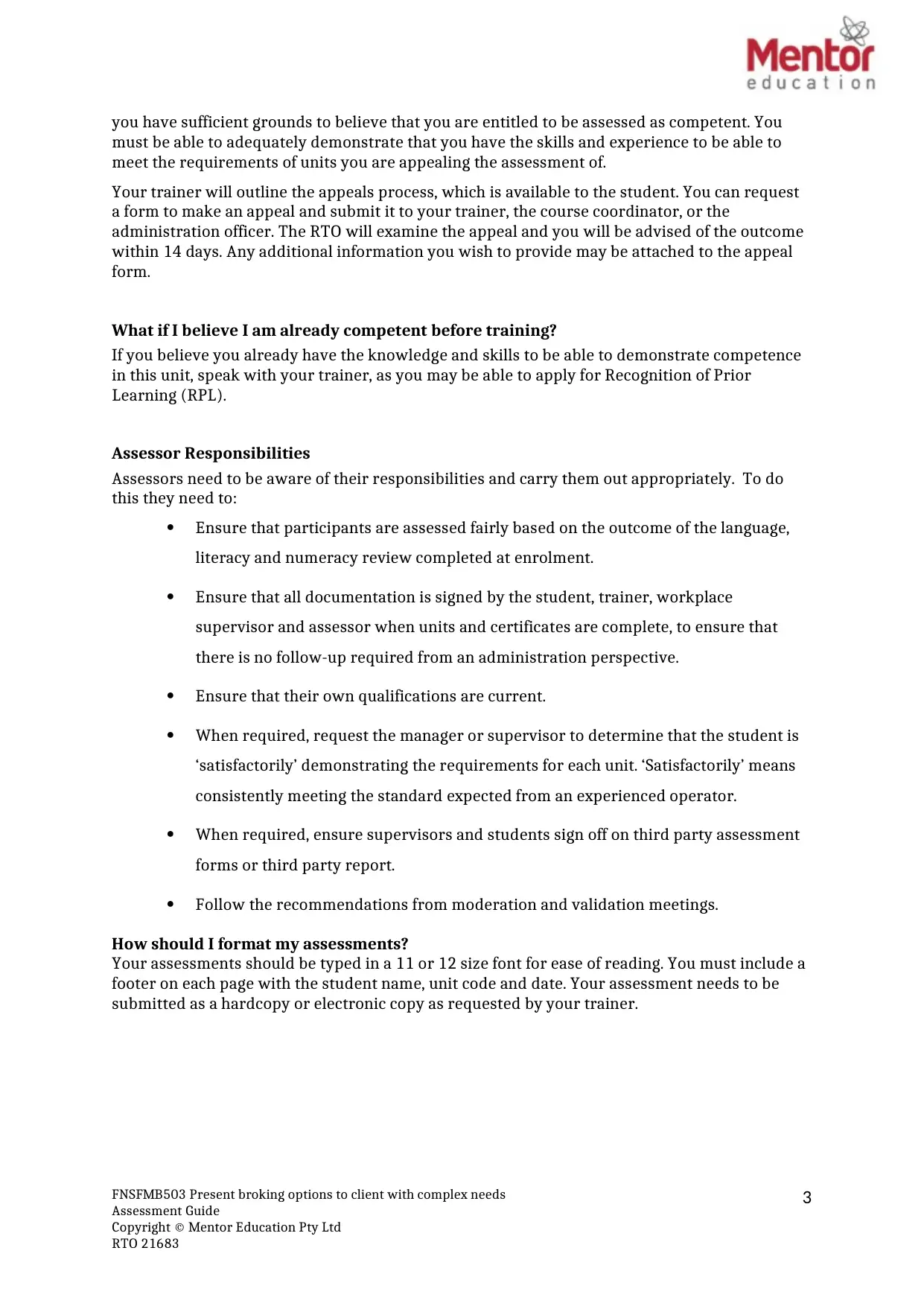
you have sufficient grounds to believe that you are entitled to be assessed as competent. You
must be able to adequately demonstrate that you have the skills and experience to be able to
meet the requirements of units you are appealing the assessment of.
Your trainer will outline the appeals process, which is available to the student. You can request
a form to make an appeal and submit it to your trainer, the course coordinator, or the
administration officer. The RTO will examine the appeal and you will be advised of the outcome
within 14 days. Any additional information you wish to provide may be attached to the appeal
form.
What if I believe I am already competent before training?
If you believe you already have the knowledge and skills to be able to demonstrate competence
in this unit, speak with your trainer, as you may be able to apply for Recognition of Prior
Learning (RPL).
Assessor Responsibilities
Assessors need to be aware of their responsibilities and carry them out appropriately. To do
this they need to:
Ensure that participants are assessed fairly based on the outcome of the language,
literacy and numeracy review completed at enrolment.
Ensure that all documentation is signed by the student, trainer, workplace
supervisor and assessor when units and certificates are complete, to ensure that
there is no follow-up required from an administration perspective.
Ensure that their own qualifications are current.
When required, request the manager or supervisor to determine that the student is
‘satisfactorily’ demonstrating the requirements for each unit. ‘Satisfactorily’ means
consistently meeting the standard expected from an experienced operator.
When required, ensure supervisors and students sign off on third party assessment
forms or third party report.
Follow the recommendations from moderation and validation meetings.
How should I format my assessments?
Your assessments should be typed in a 11 or 12 size font for ease of reading. You must include a
footer on each page with the student name, unit code and date. Your assessment needs to be
submitted as a hardcopy or electronic copy as requested by your trainer.
FNSFMB503 Present broking options to client with complex needs
Assessment Guide
Copyright © Mentor Education Pty Ltd
RTO 21683
3
must be able to adequately demonstrate that you have the skills and experience to be able to
meet the requirements of units you are appealing the assessment of.
Your trainer will outline the appeals process, which is available to the student. You can request
a form to make an appeal and submit it to your trainer, the course coordinator, or the
administration officer. The RTO will examine the appeal and you will be advised of the outcome
within 14 days. Any additional information you wish to provide may be attached to the appeal
form.
What if I believe I am already competent before training?
If you believe you already have the knowledge and skills to be able to demonstrate competence
in this unit, speak with your trainer, as you may be able to apply for Recognition of Prior
Learning (RPL).
Assessor Responsibilities
Assessors need to be aware of their responsibilities and carry them out appropriately. To do
this they need to:
Ensure that participants are assessed fairly based on the outcome of the language,
literacy and numeracy review completed at enrolment.
Ensure that all documentation is signed by the student, trainer, workplace
supervisor and assessor when units and certificates are complete, to ensure that
there is no follow-up required from an administration perspective.
Ensure that their own qualifications are current.
When required, request the manager or supervisor to determine that the student is
‘satisfactorily’ demonstrating the requirements for each unit. ‘Satisfactorily’ means
consistently meeting the standard expected from an experienced operator.
When required, ensure supervisors and students sign off on third party assessment
forms or third party report.
Follow the recommendations from moderation and validation meetings.
How should I format my assessments?
Your assessments should be typed in a 11 or 12 size font for ease of reading. You must include a
footer on each page with the student name, unit code and date. Your assessment needs to be
submitted as a hardcopy or electronic copy as requested by your trainer.
FNSFMB503 Present broking options to client with complex needs
Assessment Guide
Copyright © Mentor Education Pty Ltd
RTO 21683
3
⊘ This is a preview!⊘
Do you want full access?
Subscribe today to unlock all pages.

Trusted by 1+ million students worldwide
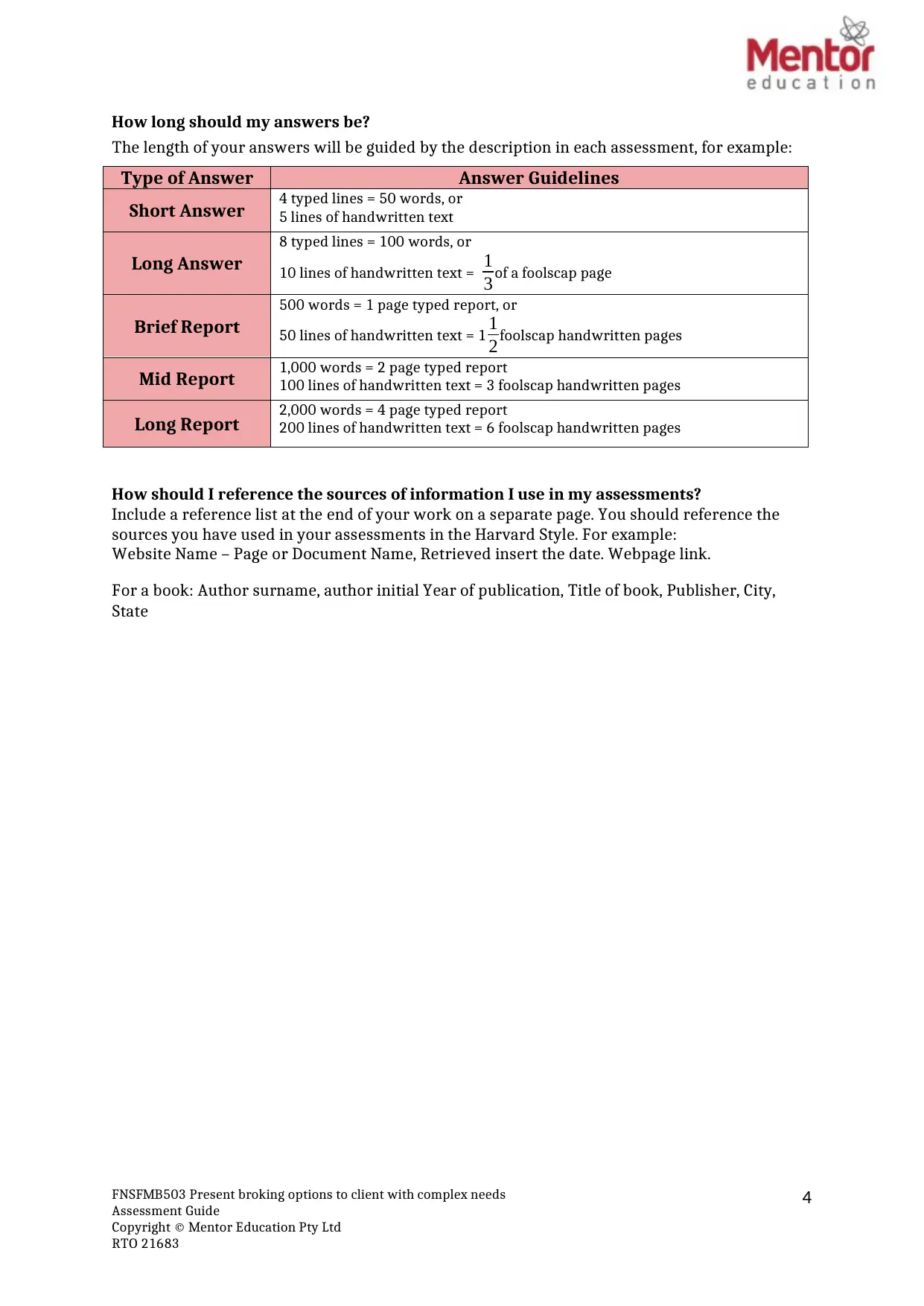
How long should my answers be?
The length of your answers will be guided by the description in each assessment, for example:
Type of Answer Answer Guidelines
Short Answer 4 typed lines = 50 words, or
5 lines of handwritten text
Long Answer
8 typed lines = 100 words, or
10 lines of handwritten text = 1
3of a foolscap page
Brief Report
500 words = 1 page typed report, or
50 lines of handwritten text = 1 1
2foolscap handwritten pages
Mid Report 1,000 words = 2 page typed report
100 lines of handwritten text = 3 foolscap handwritten pages
Long Report 2,000 words = 4 page typed report
200 lines of handwritten text = 6 foolscap handwritten pages
How should I reference the sources of information I use in my assessments?
Include a reference list at the end of your work on a separate page. You should reference the
sources you have used in your assessments in the Harvard Style. For example:
Website Name – Page or Document Name, Retrieved insert the date. Webpage link.
For a book: Author surname, author initial Year of publication, Title of book, Publisher, City,
State
FNSFMB503 Present broking options to client with complex needs
Assessment Guide
Copyright © Mentor Education Pty Ltd
RTO 21683
4
The length of your answers will be guided by the description in each assessment, for example:
Type of Answer Answer Guidelines
Short Answer 4 typed lines = 50 words, or
5 lines of handwritten text
Long Answer
8 typed lines = 100 words, or
10 lines of handwritten text = 1
3of a foolscap page
Brief Report
500 words = 1 page typed report, or
50 lines of handwritten text = 1 1
2foolscap handwritten pages
Mid Report 1,000 words = 2 page typed report
100 lines of handwritten text = 3 foolscap handwritten pages
Long Report 2,000 words = 4 page typed report
200 lines of handwritten text = 6 foolscap handwritten pages
How should I reference the sources of information I use in my assessments?
Include a reference list at the end of your work on a separate page. You should reference the
sources you have used in your assessments in the Harvard Style. For example:
Website Name – Page or Document Name, Retrieved insert the date. Webpage link.
For a book: Author surname, author initial Year of publication, Title of book, Publisher, City,
State
FNSFMB503 Present broking options to client with complex needs
Assessment Guide
Copyright © Mentor Education Pty Ltd
RTO 21683
4
Paraphrase This Document
Need a fresh take? Get an instant paraphrase of this document with our AI Paraphraser
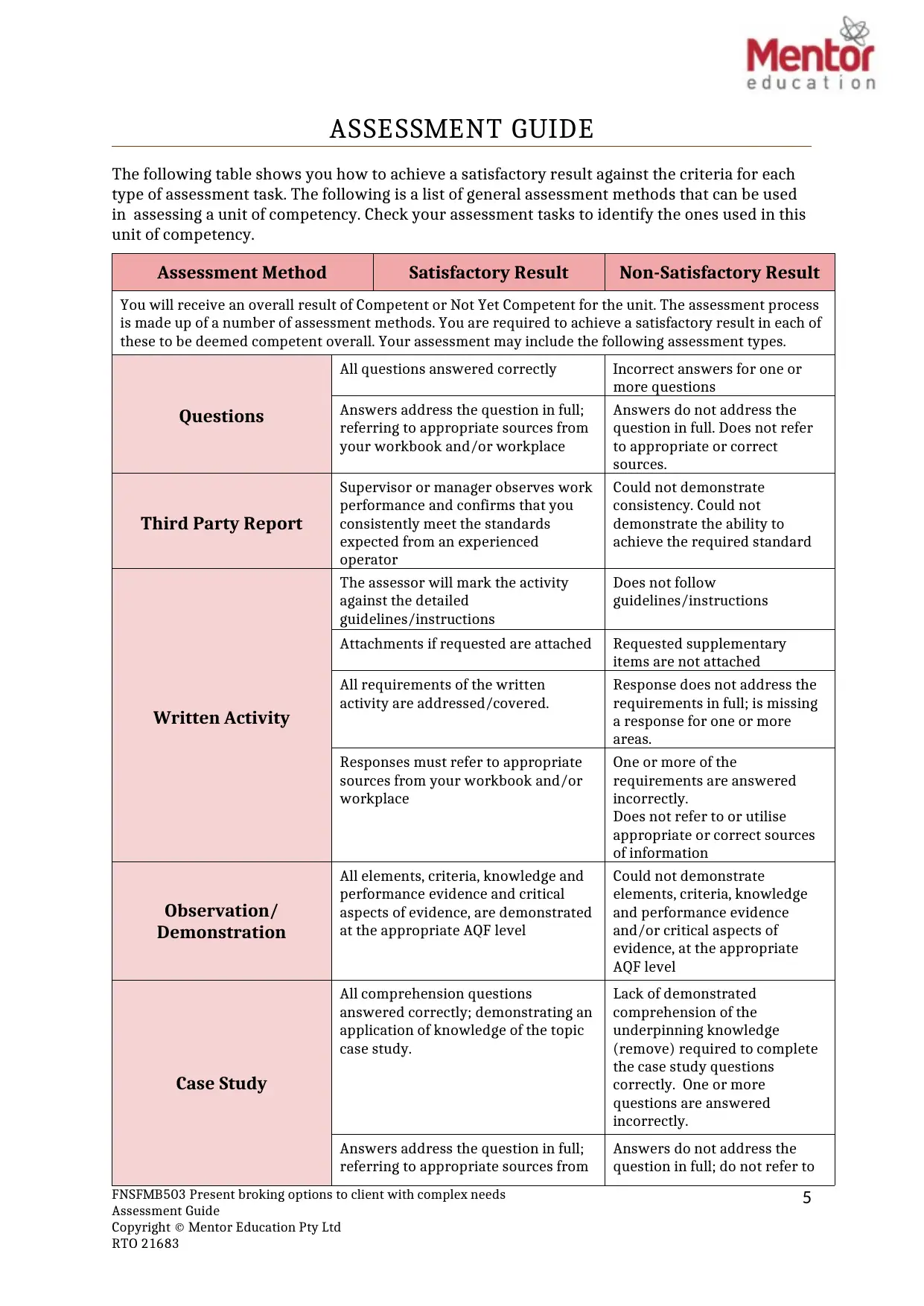
ASSESSMENT GUIDE
The following table shows you how to achieve a satisfactory result against the criteria for each
type of assessment task. The following is a list of general assessment methods that can be used
in assessing a unit of competency. Check your assessment tasks to identify the ones used in this
unit of competency.
Assessment Method Satisfactory Result Non-Satisfactory Result
You will receive an overall result of Competent or Not Yet Competent for the unit. The assessment process
is made up of a number of assessment methods. You are required to achieve a satisfactory result in each of
these to be deemed competent overall. Your assessment may include the following assessment types.
Questions
All questions answered correctly Incorrect answers for one or
more questions
Answers address the question in full;
referring to appropriate sources from
your workbook and/or workplace
Answers do not address the
question in full. Does not refer
to appropriate or correct
sources.
Third Party Report
Supervisor or manager observes work
performance and confirms that you
consistently meet the standards
expected from an experienced
operator
Could not demonstrate
consistency. Could not
demonstrate the ability to
achieve the required standard
Written Activity
The assessor will mark the activity
against the detailed
guidelines/instructions
Does not follow
guidelines/instructions
Attachments if requested are attached Requested supplementary
items are not attached
All requirements of the written
activity are addressed/covered.
Response does not address the
requirements in full; is missing
a response for one or more
areas.
Responses must refer to appropriate
sources from your workbook and/or
workplace
One or more of the
requirements are answered
incorrectly.
Does not refer to or utilise
appropriate or correct sources
of information
Observation/
Demonstration
All elements, criteria, knowledge and
performance evidence and critical
aspects of evidence, are demonstrated
at the appropriate AQF level
Could not demonstrate
elements, criteria, knowledge
and performance evidence
and/or critical aspects of
evidence, at the appropriate
AQF level
Case Study
All comprehension questions
answered correctly; demonstrating an
application of knowledge of the topic
case study.
Lack of demonstrated
comprehension of the
underpinning knowledge
(remove) required to complete
the case study questions
correctly. One or more
questions are answered
incorrectly.
Answers address the question in full;
referring to appropriate sources from
Answers do not address the
question in full; do not refer to
FNSFMB503 Present broking options to client with complex needs
Assessment Guide
Copyright © Mentor Education Pty Ltd
RTO 21683
5
The following table shows you how to achieve a satisfactory result against the criteria for each
type of assessment task. The following is a list of general assessment methods that can be used
in assessing a unit of competency. Check your assessment tasks to identify the ones used in this
unit of competency.
Assessment Method Satisfactory Result Non-Satisfactory Result
You will receive an overall result of Competent or Not Yet Competent for the unit. The assessment process
is made up of a number of assessment methods. You are required to achieve a satisfactory result in each of
these to be deemed competent overall. Your assessment may include the following assessment types.
Questions
All questions answered correctly Incorrect answers for one or
more questions
Answers address the question in full;
referring to appropriate sources from
your workbook and/or workplace
Answers do not address the
question in full. Does not refer
to appropriate or correct
sources.
Third Party Report
Supervisor or manager observes work
performance and confirms that you
consistently meet the standards
expected from an experienced
operator
Could not demonstrate
consistency. Could not
demonstrate the ability to
achieve the required standard
Written Activity
The assessor will mark the activity
against the detailed
guidelines/instructions
Does not follow
guidelines/instructions
Attachments if requested are attached Requested supplementary
items are not attached
All requirements of the written
activity are addressed/covered.
Response does not address the
requirements in full; is missing
a response for one or more
areas.
Responses must refer to appropriate
sources from your workbook and/or
workplace
One or more of the
requirements are answered
incorrectly.
Does not refer to or utilise
appropriate or correct sources
of information
Observation/
Demonstration
All elements, criteria, knowledge and
performance evidence and critical
aspects of evidence, are demonstrated
at the appropriate AQF level
Could not demonstrate
elements, criteria, knowledge
and performance evidence
and/or critical aspects of
evidence, at the appropriate
AQF level
Case Study
All comprehension questions
answered correctly; demonstrating an
application of knowledge of the topic
case study.
Lack of demonstrated
comprehension of the
underpinning knowledge
(remove) required to complete
the case study questions
correctly. One or more
questions are answered
incorrectly.
Answers address the question in full;
referring to appropriate sources from
Answers do not address the
question in full; do not refer to
FNSFMB503 Present broking options to client with complex needs
Assessment Guide
Copyright © Mentor Education Pty Ltd
RTO 21683
5
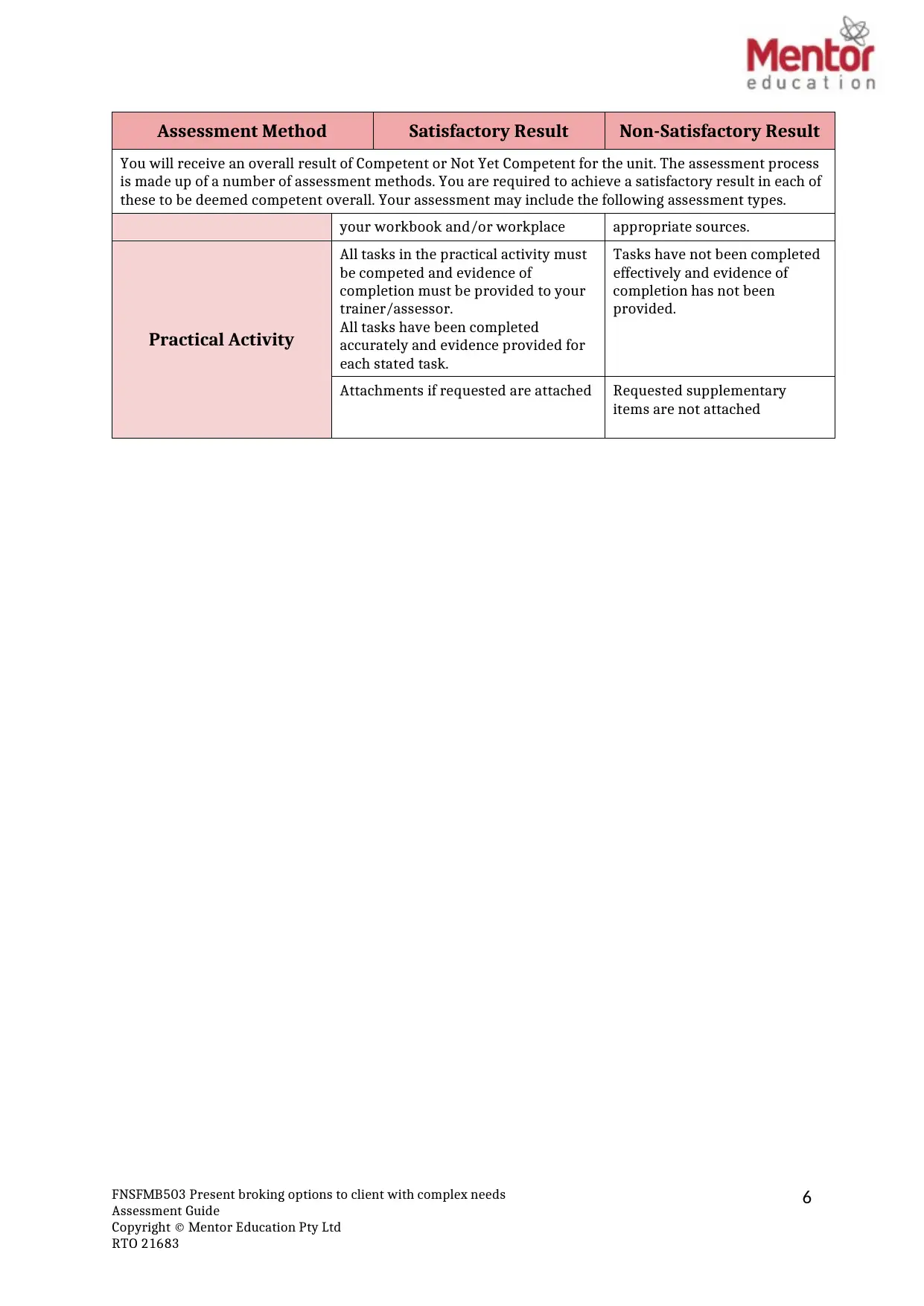
Assessment Method Satisfactory Result Non-Satisfactory Result
You will receive an overall result of Competent or Not Yet Competent for the unit. The assessment process
is made up of a number of assessment methods. You are required to achieve a satisfactory result in each of
these to be deemed competent overall. Your assessment may include the following assessment types.
your workbook and/or workplace appropriate sources.
Practical Activity
All tasks in the practical activity must
be competed and evidence of
completion must be provided to your
trainer/assessor.
All tasks have been completed
accurately and evidence provided for
each stated task.
Tasks have not been completed
effectively and evidence of
completion has not been
provided.
Attachments if requested are attached Requested supplementary
items are not attached
FNSFMB503 Present broking options to client with complex needs
Assessment Guide
Copyright © Mentor Education Pty Ltd
RTO 21683
6
You will receive an overall result of Competent or Not Yet Competent for the unit. The assessment process
is made up of a number of assessment methods. You are required to achieve a satisfactory result in each of
these to be deemed competent overall. Your assessment may include the following assessment types.
your workbook and/or workplace appropriate sources.
Practical Activity
All tasks in the practical activity must
be competed and evidence of
completion must be provided to your
trainer/assessor.
All tasks have been completed
accurately and evidence provided for
each stated task.
Tasks have not been completed
effectively and evidence of
completion has not been
provided.
Attachments if requested are attached Requested supplementary
items are not attached
FNSFMB503 Present broking options to client with complex needs
Assessment Guide
Copyright © Mentor Education Pty Ltd
RTO 21683
6
⊘ This is a preview!⊘
Do you want full access?
Subscribe today to unlock all pages.

Trusted by 1+ million students worldwide
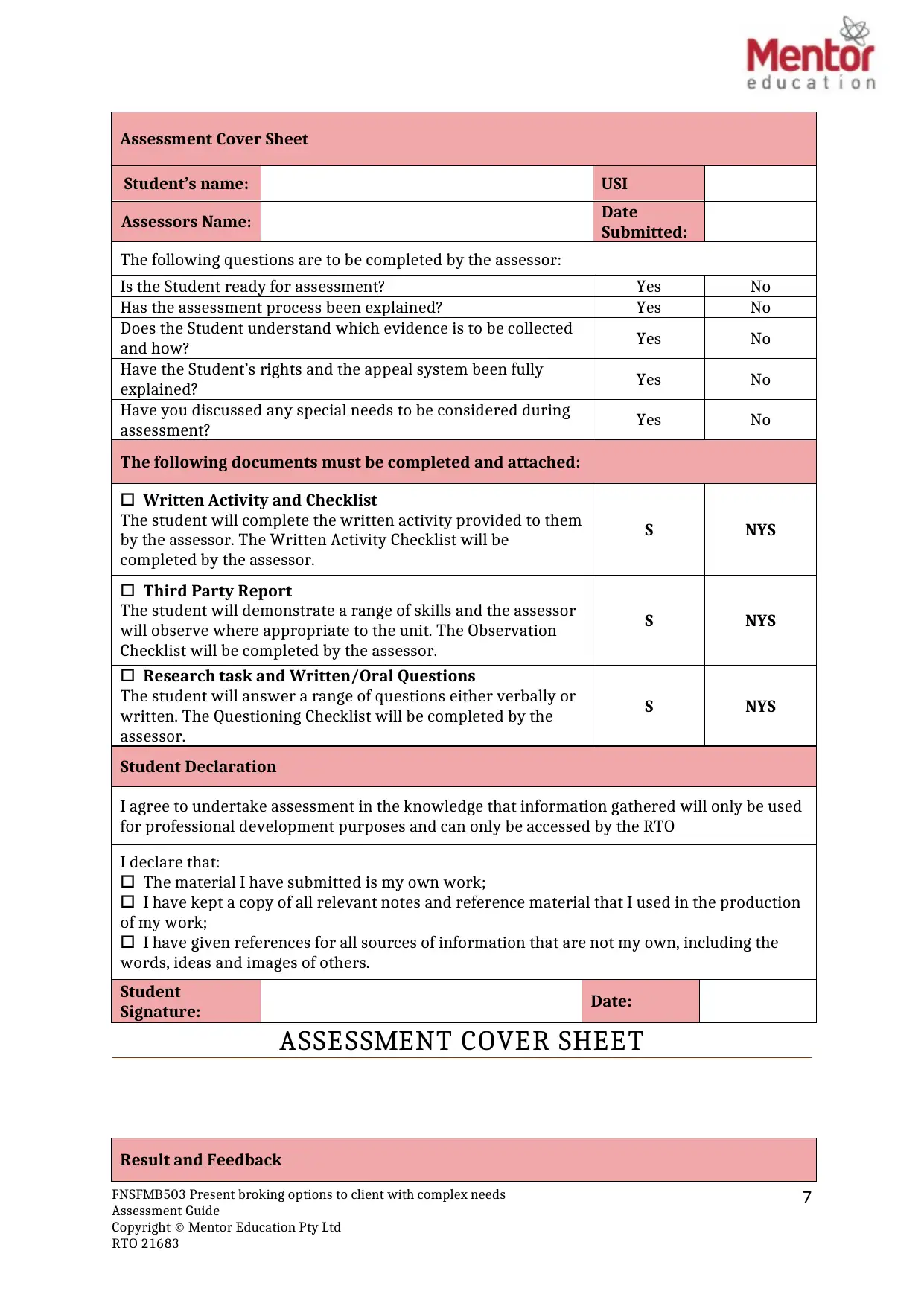
Assessment Cover Sheet
Student’s name: USI
Assessors Name: Date
Submitted:
The following questions are to be completed by the assessor:
Is the Student ready for assessment? Yes No
Has the assessment process been explained? Yes No
Does the Student understand which evidence is to be collected
and how? Yes No
Have the Student’s rights and the appeal system been fully
explained? Yes No
Have you discussed any special needs to be considered during
assessment? Yes No
The following documents must be completed and attached:
Written Activity and Checklist
The student will complete the written activity provided to them
by the assessor. The Written Activity Checklist will be
completed by the assessor.
S NYS
Third Party Report
The student will demonstrate a range of skills and the assessor
will observe where appropriate to the unit. The Observation
Checklist will be completed by the assessor.
S NYS
Research task and Written/Oral Questions
The student will answer a range of questions either verbally or
written. The Questioning Checklist will be completed by the
assessor.
S NYS
Student Declaration
I agree to undertake assessment in the knowledge that information gathered will only be used
for professional development purposes and can only be accessed by the RTO
I declare that:
The material I have submitted is my own work;
I have kept a copy of all relevant notes and reference material that I used in the production
of my work;
I have given references for all sources of information that are not my own, including the
words, ideas and images of others.
Student
Signature: Date:
ASSESSMENT COVER SHEET
Result and Feedback
FNSFMB503 Present broking options to client with complex needs
Assessment Guide
Copyright © Mentor Education Pty Ltd
RTO 21683
7
Student’s name: USI
Assessors Name: Date
Submitted:
The following questions are to be completed by the assessor:
Is the Student ready for assessment? Yes No
Has the assessment process been explained? Yes No
Does the Student understand which evidence is to be collected
and how? Yes No
Have the Student’s rights and the appeal system been fully
explained? Yes No
Have you discussed any special needs to be considered during
assessment? Yes No
The following documents must be completed and attached:
Written Activity and Checklist
The student will complete the written activity provided to them
by the assessor. The Written Activity Checklist will be
completed by the assessor.
S NYS
Third Party Report
The student will demonstrate a range of skills and the assessor
will observe where appropriate to the unit. The Observation
Checklist will be completed by the assessor.
S NYS
Research task and Written/Oral Questions
The student will answer a range of questions either verbally or
written. The Questioning Checklist will be completed by the
assessor.
S NYS
Student Declaration
I agree to undertake assessment in the knowledge that information gathered will only be used
for professional development purposes and can only be accessed by the RTO
I declare that:
The material I have submitted is my own work;
I have kept a copy of all relevant notes and reference material that I used in the production
of my work;
I have given references for all sources of information that are not my own, including the
words, ideas and images of others.
Student
Signature: Date:
ASSESSMENT COVER SHEET
Result and Feedback
FNSFMB503 Present broking options to client with complex needs
Assessment Guide
Copyright © Mentor Education Pty Ltd
RTO 21683
7
Paraphrase This Document
Need a fresh take? Get an instant paraphrase of this document with our AI Paraphraser
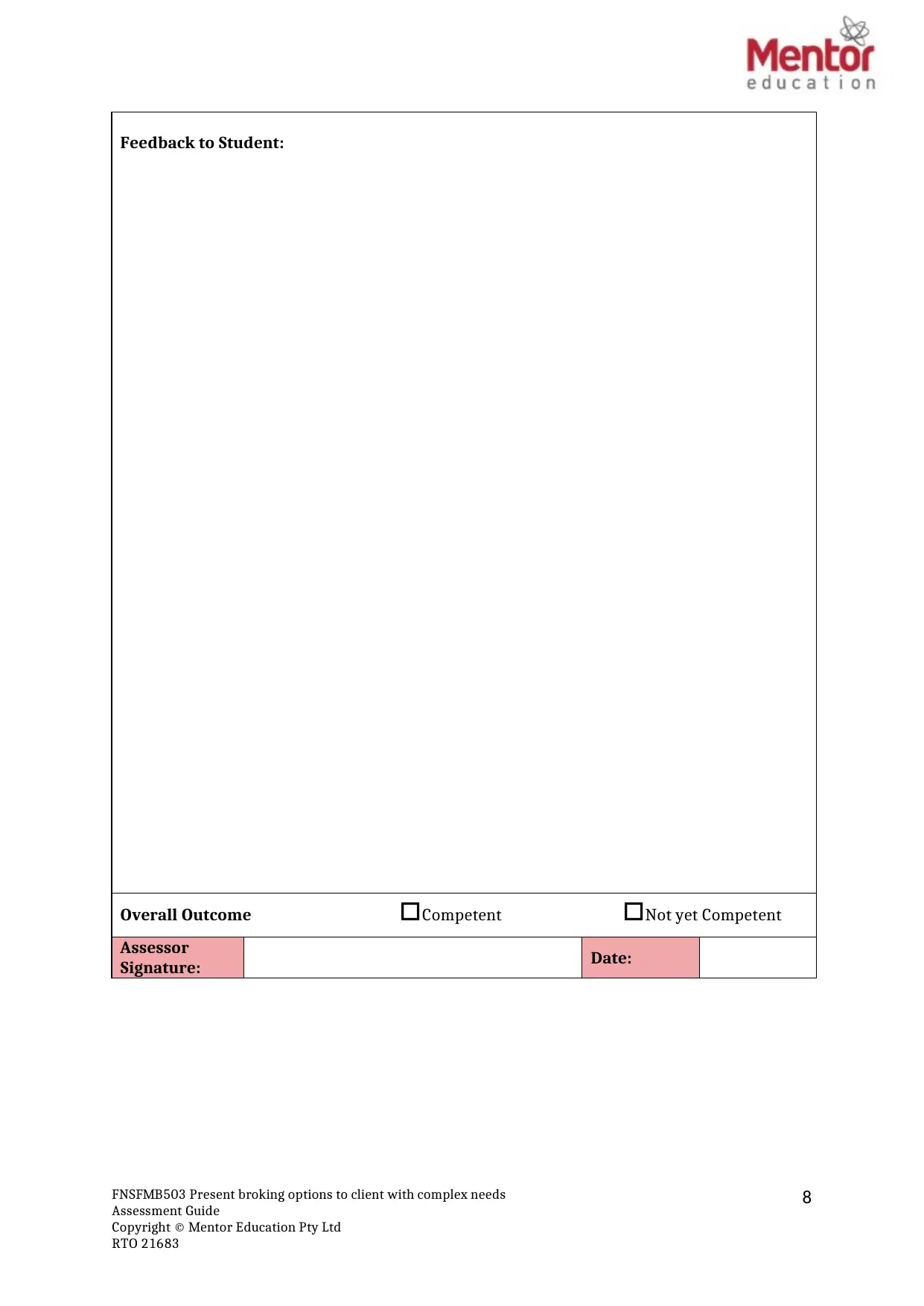
Feedback to Student:
Overall Outcome Competent Not yet Competent
Assessor
Signature: Date:
FNSFMB503 Present broking options to client with complex needs
Assessment Guide
Copyright © Mentor Education Pty Ltd
RTO 21683
8
Overall Outcome Competent Not yet Competent
Assessor
Signature: Date:
FNSFMB503 Present broking options to client with complex needs
Assessment Guide
Copyright © Mentor Education Pty Ltd
RTO 21683
8
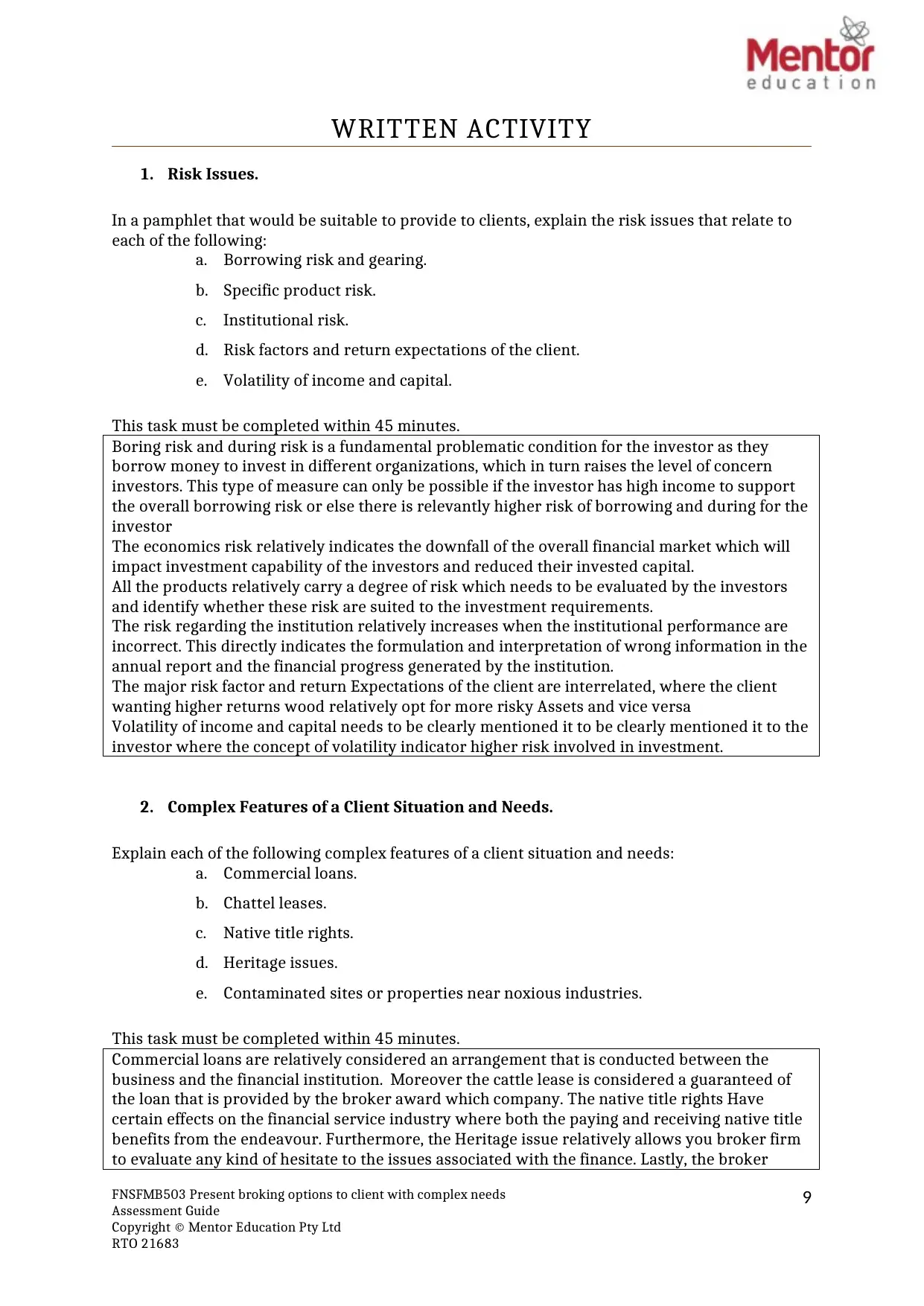
WRITTEN ACTIVITY
1. Risk Issues.
In a pamphlet that would be suitable to provide to clients, explain the risk issues that relate to
each of the following:
a. Borrowing risk and gearing.
b. Specific product risk.
c. Institutional risk.
d. Risk factors and return expectations of the client.
e. Volatility of income and capital.
This task must be completed within 45 minutes.
Boring risk and during risk is a fundamental problematic condition for the investor as they
borrow money to invest in different organizations, which in turn raises the level of concern
investors. This type of measure can only be possible if the investor has high income to support
the overall borrowing risk or else there is relevantly higher risk of borrowing and during for the
investor
The economics risk relatively indicates the downfall of the overall financial market which will
impact investment capability of the investors and reduced their invested capital.
All the products relatively carry a degree of risk which needs to be evaluated by the investors
and identify whether these risk are suited to the investment requirements.
The risk regarding the institution relatively increases when the institutional performance are
incorrect. This directly indicates the formulation and interpretation of wrong information in the
annual report and the financial progress generated by the institution.
The major risk factor and return Expectations of the client are interrelated, where the client
wanting higher returns wood relatively opt for more risky Assets and vice versa
Volatility of income and capital needs to be clearly mentioned it to be clearly mentioned it to the
investor where the concept of volatility indicator higher risk involved in investment.
2. Complex Features of a Client Situation and Needs.
Explain each of the following complex features of a client situation and needs:
a. Commercial loans.
b. Chattel leases.
c. Native title rights.
d. Heritage issues.
e. Contaminated sites or properties near noxious industries.
This task must be completed within 45 minutes.
Commercial loans are relatively considered an arrangement that is conducted between the
business and the financial institution. Moreover the cattle lease is considered a guaranteed of
the loan that is provided by the broker award which company. The native title rights Have
certain effects on the financial service industry where both the paying and receiving native title
benefits from the endeavour. Furthermore, the Heritage issue relatively allows you broker firm
to evaluate any kind of hesitate to the issues associated with the finance. Lastly, the broker
FNSFMB503 Present broking options to client with complex needs
Assessment Guide
Copyright © Mentor Education Pty Ltd
RTO 21683
9
1. Risk Issues.
In a pamphlet that would be suitable to provide to clients, explain the risk issues that relate to
each of the following:
a. Borrowing risk and gearing.
b. Specific product risk.
c. Institutional risk.
d. Risk factors and return expectations of the client.
e. Volatility of income and capital.
This task must be completed within 45 minutes.
Boring risk and during risk is a fundamental problematic condition for the investor as they
borrow money to invest in different organizations, which in turn raises the level of concern
investors. This type of measure can only be possible if the investor has high income to support
the overall borrowing risk or else there is relevantly higher risk of borrowing and during for the
investor
The economics risk relatively indicates the downfall of the overall financial market which will
impact investment capability of the investors and reduced their invested capital.
All the products relatively carry a degree of risk which needs to be evaluated by the investors
and identify whether these risk are suited to the investment requirements.
The risk regarding the institution relatively increases when the institutional performance are
incorrect. This directly indicates the formulation and interpretation of wrong information in the
annual report and the financial progress generated by the institution.
The major risk factor and return Expectations of the client are interrelated, where the client
wanting higher returns wood relatively opt for more risky Assets and vice versa
Volatility of income and capital needs to be clearly mentioned it to be clearly mentioned it to the
investor where the concept of volatility indicator higher risk involved in investment.
2. Complex Features of a Client Situation and Needs.
Explain each of the following complex features of a client situation and needs:
a. Commercial loans.
b. Chattel leases.
c. Native title rights.
d. Heritage issues.
e. Contaminated sites or properties near noxious industries.
This task must be completed within 45 minutes.
Commercial loans are relatively considered an arrangement that is conducted between the
business and the financial institution. Moreover the cattle lease is considered a guaranteed of
the loan that is provided by the broker award which company. The native title rights Have
certain effects on the financial service industry where both the paying and receiving native title
benefits from the endeavour. Furthermore, the Heritage issue relatively allows you broker firm
to evaluate any kind of hesitate to the issues associated with the finance. Lastly, the broker
FNSFMB503 Present broking options to client with complex needs
Assessment Guide
Copyright © Mentor Education Pty Ltd
RTO 21683
9
⊘ This is a preview!⊘
Do you want full access?
Subscribe today to unlock all pages.

Trusted by 1+ million students worldwide
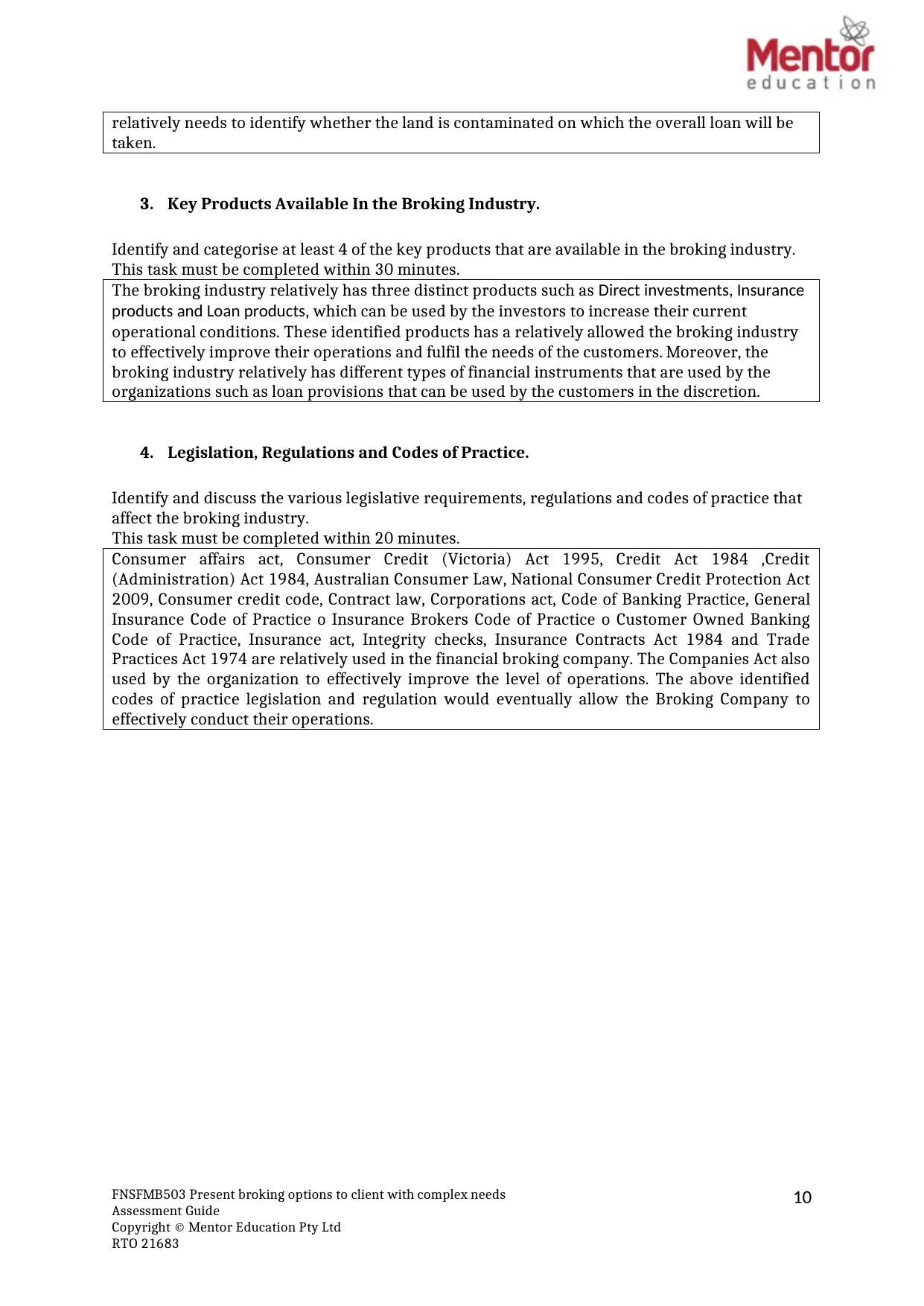
relatively needs to identify whether the land is contaminated on which the overall loan will be
taken.
3. Key Products Available In the Broking Industry.
Identify and categorise at least 4 of the key products that are available in the broking industry.
This task must be completed within 30 minutes.
The broking industry relatively has three distinct products such as Direct investments, Insurance
products and Loan products, which can be used by the investors to increase their current
operational conditions. These identified products has a relatively allowed the broking industry
to effectively improve their operations and fulfil the needs of the customers. Moreover, the
broking industry relatively has different types of financial instruments that are used by the
organizations such as loan provisions that can be used by the customers in the discretion.
4. Legislation, Regulations and Codes of Practice.
Identify and discuss the various legislative requirements, regulations and codes of practice that
affect the broking industry.
This task must be completed within 20 minutes.
Consumer affairs act, Consumer Credit (Victoria) Act 1995, Credit Act 1984 ,Credit
(Administration) Act 1984, Australian Consumer Law, National Consumer Credit Protection Act
2009, Consumer credit code, Contract law, Corporations act, Code of Banking Practice, General
Insurance Code of Practice o Insurance Brokers Code of Practice o Customer Owned Banking
Code of Practice, Insurance act, Integrity checks, Insurance Contracts Act 1984 and Trade
Practices Act 1974 are relatively used in the financial broking company. The Companies Act also
used by the organization to effectively improve the level of operations. The above identified
codes of practice legislation and regulation would eventually allow the Broking Company to
effectively conduct their operations.
FNSFMB503 Present broking options to client with complex needs
Assessment Guide
Copyright © Mentor Education Pty Ltd
RTO 21683
10
taken.
3. Key Products Available In the Broking Industry.
Identify and categorise at least 4 of the key products that are available in the broking industry.
This task must be completed within 30 minutes.
The broking industry relatively has three distinct products such as Direct investments, Insurance
products and Loan products, which can be used by the investors to increase their current
operational conditions. These identified products has a relatively allowed the broking industry
to effectively improve their operations and fulfil the needs of the customers. Moreover, the
broking industry relatively has different types of financial instruments that are used by the
organizations such as loan provisions that can be used by the customers in the discretion.
4. Legislation, Regulations and Codes of Practice.
Identify and discuss the various legislative requirements, regulations and codes of practice that
affect the broking industry.
This task must be completed within 20 minutes.
Consumer affairs act, Consumer Credit (Victoria) Act 1995, Credit Act 1984 ,Credit
(Administration) Act 1984, Australian Consumer Law, National Consumer Credit Protection Act
2009, Consumer credit code, Contract law, Corporations act, Code of Banking Practice, General
Insurance Code of Practice o Insurance Brokers Code of Practice o Customer Owned Banking
Code of Practice, Insurance act, Integrity checks, Insurance Contracts Act 1984 and Trade
Practices Act 1974 are relatively used in the financial broking company. The Companies Act also
used by the organization to effectively improve the level of operations. The above identified
codes of practice legislation and regulation would eventually allow the Broking Company to
effectively conduct their operations.
FNSFMB503 Present broking options to client with complex needs
Assessment Guide
Copyright © Mentor Education Pty Ltd
RTO 21683
10
Paraphrase This Document
Need a fresh take? Get an instant paraphrase of this document with our AI Paraphraser
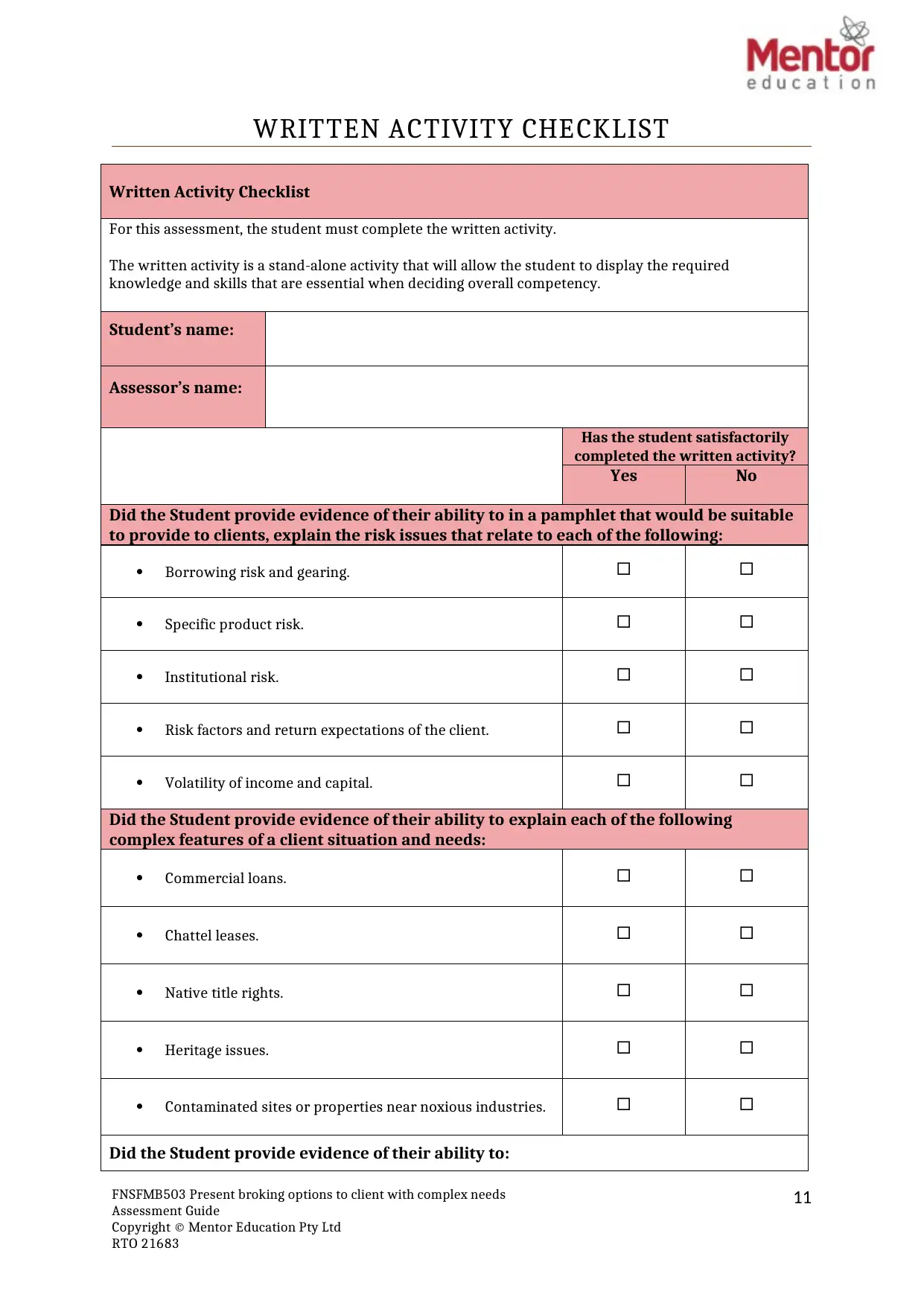
WRITTEN ACTIVITY CHECKLIST
Written Activity Checklist
For this assessment, the student must complete the written activity.
The written activity is a stand-alone activity that will allow the student to display the required
knowledge and skills that are essential when deciding overall competency.
Student’s name:
Assessor’s name:
Has the student satisfactorily
completed the written activity?
Yes No
Did the Student provide evidence of their ability to in a pamphlet that would be suitable
to provide to clients, explain the risk issues that relate to each of the following:
Borrowing risk and gearing.
Specific product risk.
Institutional risk.
Risk factors and return expectations of the client.
Volatility of income and capital.
Did the Student provide evidence of their ability to explain each of the following
complex features of a client situation and needs:
Commercial loans.
Chattel leases.
Native title rights.
Heritage issues.
Contaminated sites or properties near noxious industries.
Did the Student provide evidence of their ability to:
FNSFMB503 Present broking options to client with complex needs
Assessment Guide
Copyright © Mentor Education Pty Ltd
RTO 21683
11
Written Activity Checklist
For this assessment, the student must complete the written activity.
The written activity is a stand-alone activity that will allow the student to display the required
knowledge and skills that are essential when deciding overall competency.
Student’s name:
Assessor’s name:
Has the student satisfactorily
completed the written activity?
Yes No
Did the Student provide evidence of their ability to in a pamphlet that would be suitable
to provide to clients, explain the risk issues that relate to each of the following:
Borrowing risk and gearing.
Specific product risk.
Institutional risk.
Risk factors and return expectations of the client.
Volatility of income and capital.
Did the Student provide evidence of their ability to explain each of the following
complex features of a client situation and needs:
Commercial loans.
Chattel leases.
Native title rights.
Heritage issues.
Contaminated sites or properties near noxious industries.
Did the Student provide evidence of their ability to:
FNSFMB503 Present broking options to client with complex needs
Assessment Guide
Copyright © Mentor Education Pty Ltd
RTO 21683
11
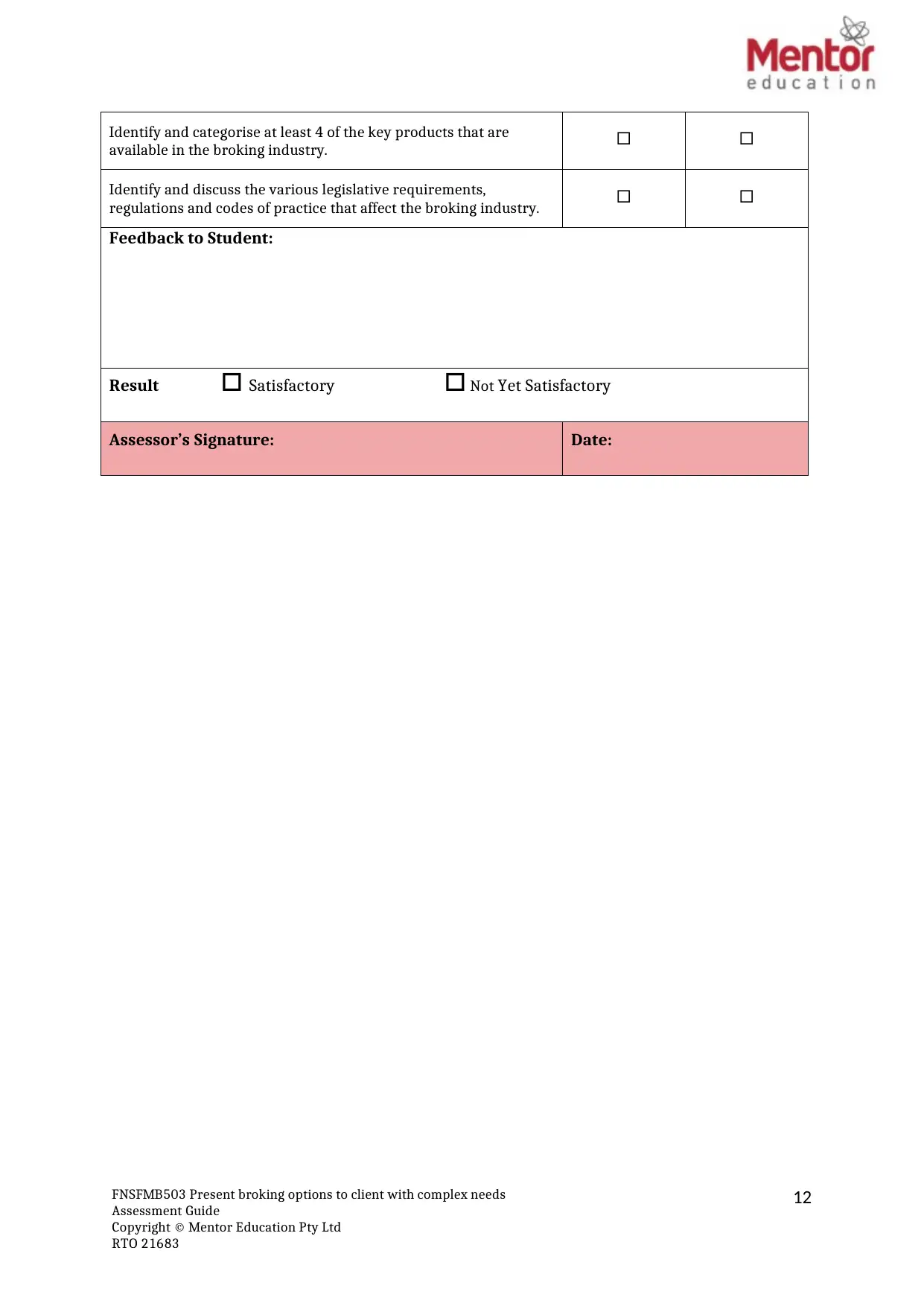
Identify and categorise at least 4 of the key products that are
available in the broking industry.
Identify and discuss the various legislative requirements,
regulations and codes of practice that affect the broking industry.
Feedback to Student:
Result Satisfactory Not Yet Satisfactory
Assessor’s Signature: Date:
FNSFMB503 Present broking options to client with complex needs
Assessment Guide
Copyright © Mentor Education Pty Ltd
RTO 21683
12
available in the broking industry.
Identify and discuss the various legislative requirements,
regulations and codes of practice that affect the broking industry.
Feedback to Student:
Result Satisfactory Not Yet Satisfactory
Assessor’s Signature: Date:
FNSFMB503 Present broking options to client with complex needs
Assessment Guide
Copyright © Mentor Education Pty Ltd
RTO 21683
12
⊘ This is a preview!⊘
Do you want full access?
Subscribe today to unlock all pages.

Trusted by 1+ million students worldwide
1 out of 28
Related Documents
Your All-in-One AI-Powered Toolkit for Academic Success.
+13062052269
info@desklib.com
Available 24*7 on WhatsApp / Email
![[object Object]](/_next/static/media/star-bottom.7253800d.svg)
Unlock your academic potential
Copyright © 2020–2025 A2Z Services. All Rights Reserved. Developed and managed by ZUCOL.





